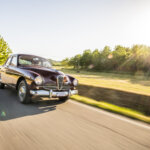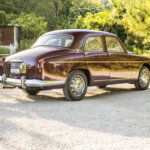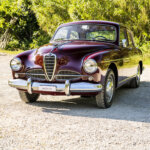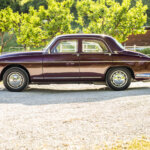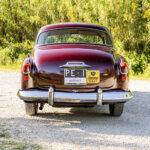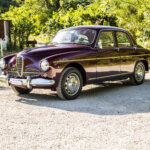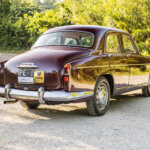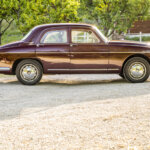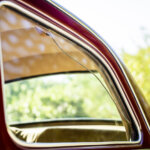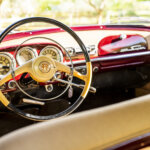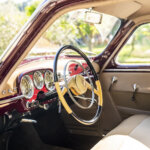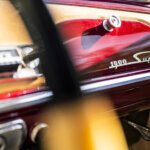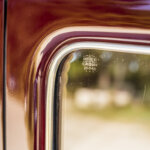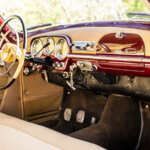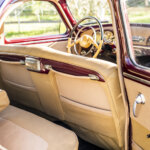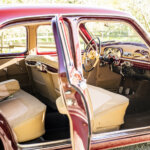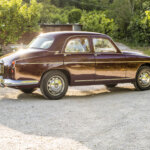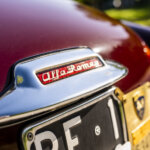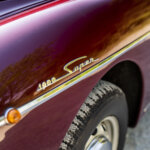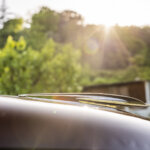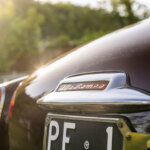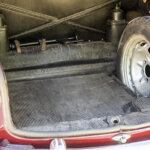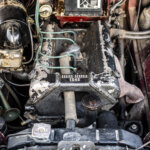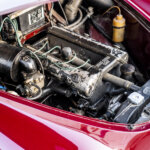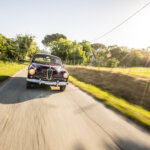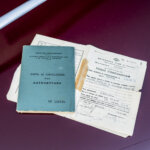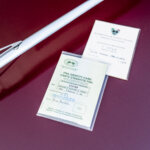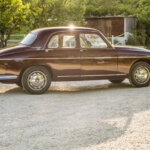AUTO D'EPOCA - ALFA ROMEO 1900 SUPER, 1956, AMARANTO
(English text below)
La presente 1900 Super venne prodotta il 9 ottobre 1956 ed immatricolata a Pescara il 12 Febbraio 1957, dove rimase per 25 anni con un solo passaggio di proprietà nel 1964. A fine del 1982 l’auto giunse in Romagna, prima di passare nelle mani dell’attuale proprietario nel 1985.
Nello splendido colore Amaranto, con interni in panno beige l’auto si presenta in ottime condizioni, dopo essere stata sottoposta negli anni passati ad un restauro conservativo, conservando il motore di primo equipaggiamento.
L’auto conserva la targa di prima immatricolazione, il foglio complementare ed il libretto a pagine; completano il corredo le omologazioni ASI e FIVA.
Vettura in ordine, utilizzata regolarmente per raduni e manifestazioni, bisognosa solo di ordinaria manutenzione. Visibile previo appuntamento a Cesena.
Maggiori dettagli su www.gulfblue.it
Note storiche:
Da tempo l’Alfa Romeo intendeva sostituire l’ormai obsoleta e pesante 2500 con una vettura moderna, al passo con le nuove tecnologie, che ormai proponevano la carrozzeria con scocca integrata al telaio. Non solo, ma la soluzione per il mantenimento dell’azienda a dimensioni industriali, in condizioni di garantire quindi un certo livello di occupazione, non poteva che risolversi con l’abbandono di vetture sofisticate e costose, destinate a quella stessa clientela esclusivamente d’élite che aveva caratterizzato l’Alfa Romeo fin dalle sue origini. Si rendeva indispensabile optare invece per un progetto che consentisse di realizzare una vettura di larga diffusione, pur con elevati standard di qualità e prestazioni di rilievo. Anche per il motore, l’imperativo tu dimenticare il sei cilindri e pensare a un quattro cilindri di concezione più semplice, la cui imposizione fiscale si sarebbe rivelata meno gravosa. Si volle tuttavia mantenere la tradizionale consolidata impostazione Alfa Romeo, che traeva origine dalle corse e che non poteva prescindere dal tipico doppio albero a camme in testa. Tutta la meccanica risentiva positivamente dell’esperienza agonistica: le efficientissime sospensioni, l’impianto frenante, uno dei più efficaci del periodo, la guidabilità veramente superiore. Tutte doti che, oltre alla raffinatezza del progetto, evidenziavano il lungo lavoro di sviluppo posto in atto dai mitici collaudatori della Casa capeggiati da Giambattista Guidotti e da Consalvo Sanesi.
Con la 1900, prima creatura di Orazio Satta e di Giuseppe Busso, che collaborò alla progettazione della meccanica, si ebbe una vera e propria svolta tecnica che improntò il corso futuro dell’azienda. Per la carrozzeria, capolavoro di soluzione a scocca portante, si fece ricorso a tutta l’esperienza di Ivo Colucci, che da due anni aveva assunto la direzione del reparto carrozzerie.
Ma la 1900 segnò anche un’altra svolta importante: il trasferimento della guida sul lato sinistro della vettura. A eccezione infatti di alcune auto da corsa, che furono ancora allestite con guida a destra, dalla 1900 in avanti tutta la produzione Alfa Romeo nacque sempre con guida a sinistra, tranne, ovviamente, per le vetture destinate ai Paesi con circolazione a sinistra.
L’alimentazione del motore era assicurata, in alternativa, da un carburatore invertito Solex 33 PBIC, Solex 40 PAI oppure Weber 40 CF5; quest’ultimo poteva essere sostituito dai tipi 40 DCL5 e 40 DCZ5. Con l’adozione dei carburatori Solex 40 PAI e Weber 40 DCF5 la potenza saliva a 85 CV al regime di 5200 giri/min.
Selleria in panno e tappeti in moquette di lana e gomma. Parti metalliche cromate. Ben presto le ruote da 16 pollici di diametro, adatte al montaggio di pneumatici convenzionali 6.00×16, furono sostituite dalle 165×400 adatte ai nuovi pneumatici a carcassa radiale.
La 1900 Super nacque aumentando il solo alesaggio e lasciando invariata la corsa, si ottenne un motore più potente e più affidabile, anche perché dalla primavera del 1955 si adottarono due catene della distribuzione silenziose in luogo del comando misto a ingranaggi e catena. Oltre all’adozione di un nuovo basamento, il mutato senso di rotazione degli alberi a camme comportò la modifica dell’ordine di accensione dei cilindri (1-2-4-3) che, per facilitare le operazioni di manutenzione, dovette essere indicato, in rilievo, sulla testata. Alimentazione a mezzo di un carburatore Solex 40 PAI. Tutti questi accorgimenti portarono la potenza a 90cv.
Nuovo il cruscotto, con strumenti circolari, che comprendeva il contachilometri, il contagiri e lo strumento che incorporava il manometro dell’olio, il livello della benzina e la temperatura dell’acqua. La selleria era in panno e finta pelle, mentre i tappeti erano in moquette di lana e gomma. Ruote con finestre ovali, atte a raffreddare i tamburi dei freni, che tuttavia erano già apparse sulla 1900 berlina.
All’atto della presentazione, eccettuati i nuovi gruppi ottici posteriori (comprendenti la luce di posizione, lo stop e l’indicatore di direzione di colore giallo) e i rostri ai paraurti, la carrozzeria era ancora molto simile alla precedente berlina. Verso la fine del 1954 la vettura subì un leggero restyling, che si limitò a un profilo cromato che delimitava la curvatura delle porte in prossimità dei vetri, un secondo profilo cromato che correva lungo tutta la fiancata e un altro ancora alla base delle porte. Figurava anche un fregio fra il lunotto e la porta posteriore, mentre quasi all’estremità del parafango anteriore era stata
collocata la scritta “1900 Super”.
Fonte: “Alfa Romeo, le vetture di produzione”, Stefano d’Amico, Maurizio Tabucchi, Giunti-Nada.
__________________________________
This wonderful Alfa Romeo 1900 Super was produced the 9th October 1956 and registered in Pescara on February 12, 1957 where it remained there for 25 years with just one change of ownership in 1964. At the end of 1982 the car arrived in Romagna, before passing into the hands of the current owner in 1985.
In the splendid Amaranto colour (Dark red), with beige cloth interior, the car is in splendid condition, after having undergone a conservative restoration in the past years, keeping the first equipment engine.
The car retains the first registration plate, the complementary sheet (Foglio complementare) and the old tile (Libretto); ASI and FIVA certificates come with the car.
Mechanically the car runs good, it was used regularly for rallies and events; it only needs the ordinary maintenance. Visible by appointment in Cesena.
Further details on www.gulfblue.it
Historical notes:
AIfa Romeo had been planning for some time to replace the heavy, obsolete 2500 with a modern car featuring up-to-date integrated bodyshell and chassis technology. Moreover, the decision to maintain the company as a major industrial concern capable of providing employment for a large workforce meant that the sophisticated, expensive cars destined for the elite clientele that had favoured Alfa Romeo from its very origins inevitably had
1900 to be abandoned. What was indispensable was an economical design for a mass produced car that nonetheless retained certain standards of quality and performance.
Similarly, in the case of the engines, the six cylinder units had to be put to one while
The firm concentrated its efforts on a simpler four-cylinder unit that would attract a lighter
fiscal burden. However, the company wished to retain the established Alfa traditions that had grown out of its competition heritage and could hardly forego its twin overhead camshaft engine architecture. The entire mechanical specification of the 1900 revealed the
benefits of the firm’s competition experience: the extremely efficient suspension, the braking system that was one of the best of its era and its truly superior headling. These were all qualities that, along with the general sophistication of the design, highlighted
the lengthy development work carried out by the company’s legendary testers
under the direction of Giambattista Guidotti and Consalvo Sanesi.
The 1900, the first car attributed to Orazio Satta Puliga and Giuseppe Busso (who assisted
on the mechanical side), represented a technological turning point of crucial importance to the future of the company. The bodyshell, a masterpiece of unitary construction features, benefited from the long experience of Ivo Colucci who had taken over responsibility
for the coachwork department two years earlier.
However, the 1900 also marked another important turning point: the switch to left-hand drive. In fact, with the exception of certain competition cars still prepared with right-hand drive, from the 1900 onwards all Alfa Romeos were built with left-hand drive unless specifically destined for those countries that drive on the left.
Carburettors: Solex 33 PBIC, Solex 40 PAI, Weber 40 DCF5; the latter could be replaced with the 40 DCL5 and 40 DCZ5 types. With the adoption of the Solex 40 PAI and the Weber 40 DCF5 carbs, power output rose to 85 hp at 5200 rpm.
Cloth upholstery and wool and rubber mats were fitted. The brightwork was chrome-plated. The 16″-diameter wheels suitable for the mounting of conventional 6.00×16 tyres were soon replaced by 165×400 wheels designed for the new radial tyres.
The 1900 Super was born by increasing the bore diameter and leaving the stroke unchanged, Alfa created a more powerful engine that was also more reliable as from the spring of 1955 duplex silent chains drove the valvegear rather than the earlier mixed gear and chain system.
Apart from the adoption of a new crankcase, the change in the direction of rotation of the camshafts led to a modification in the firing order (1-2-4-3). So as to simplify maintenance operations, this order was cast in relief on the cylinder head.
A Solex 40 PAI carburettor was fitted. The dashboard was new and featured circular instrumentation comprising a speedometer, a rev-counter and a single dial containing oil
pressure, water temperature and fuel level gauges. The interior was trimmed in cloth and imitation leather and wool and rubber mats were fitted. The wheels featured oval perforations (already seen on the 1900 berlina) to aid brake drum cooling.
When the car was presented the coachwork was very similar to the earlier berlina with the exception of the new rear lighting clusters (including rear light brake light and yellow indicator) and overriders on the bumpers. Towards the end of 1954 the car was the subject of a minor restyling exercise comprising the addition of a chromed strip highlighting the curvature of the doors below the window frames, a second chromed strip running the length of the flanks and a third along the sills.
There was also a decorative element between the rear window and the rear door and the “1900 Super” script was added to front wing.
Source: “Alfa Romeo, le vetture di produzione”, Stefano d’Amico, Maurizio Tabucchi, Giunti-Nada.
Photos credit: Rémi Dargegen
- Modello: 1900 - Berlina
- Alimentazione: Benzina
- Paese: Italia
- Paese d'origine: Italia
- Chilometri: -
- Trazione: Posteriore
- Tipologia: Berlina/City Car
- Trattativa riservata
- Allestimenti e optional: panno beige
- Posti: 6
- Anno: 1956
- Stato: restaurato

